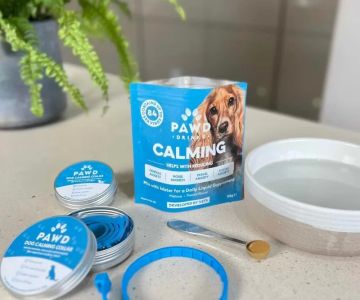How to Prevent Dog Ticks: Essential Tips for Your Dog's Health
As a dog owner, one of the most concerning issues I’ve faced is dealing with ticks. These small, yet dangerous creatures can cause a variety of health problems for our furry friends, including Lyme disease and other tick-borne illnesses. Ticks tend to thrive in grassy, wooded areas, which means they’re particularly active during the warmer months. Over the years, I’ve learned a lot about how to prevent ticks on dogs and how to take care of them when they do appear. Here, I’ll share the best strategies for preventing dog ticks and keeping your dog healthy and happy.

980 E Northwest Hwy, Arlington Heights, IL 60004, USA
See Details1. Understanding the Risks of Ticks
Ticks can be more than just an annoying pest. They are capable of transmitting a range of diseases, making it important to take tick prevention seriously. I remember the first time I found a tick on my dog – I was shocked and a little scared, not knowing how dangerous it could be. Ticks are known to transmit diseases such as Lyme disease, ehrlichiosis, and Rocky Mountain spotted fever. These diseases can lead to serious health problems in dogs, including fever, lethargy, and in extreme cases, organ damage.
It's essential to understand that ticks can be extremely small, sometimes as tiny as a pinhead, which makes them easy to overlook. They attach themselves to a dog’s skin and feed on their blood, often without being noticed until they’ve been on the dog for a while. The longer a tick stays on your dog, the higher the chances of disease transmission. This is why regular checks and preventative measures are so important.
2. Regularly Check Your Dog for Ticks
The first step in tick prevention is simple: regular check-ups. I personally make it a habit to check my dog’s coat after every walk, especially if we’ve been in areas with tall grass, bushes, or woods. Ticks can latch onto your dog in seconds, so it’s crucial to check thoroughly. I use a fine-toothed comb to go through their fur, paying special attention to places where ticks are likely to hide, such as around the ears, under the collar, and between the toes.
In addition to visual checks, feel for any unusual bumps or lumps on your dog’s body. If you find a tick, remove it carefully using a pair of fine-tipped tweezers or a tick removal tool. Make sure to grasp the tick by the head, as pulling from the body can leave parts of the tick embedded in your dog’s skin. I’ve found that performing a tick check after each outdoor adventure has become a routine part of taking care of my dog.
3. Use Tick Prevention Products
While regular checks are crucial, using tick prevention products is just as important. Over the years, I’ve tried various products, and I’ve learned which ones work best for my dog. Here are some of the most effective tick prevention products you can consider:
- Tick Collars: A good quality tick collar can provide long-lasting protection against ticks. Some collars are even waterproof, which is a great feature for dogs who enjoy swimming or playing in the rain. I personally use a collar that’s designed to repel both ticks and fleas, and it’s worked wonders.
- Topical Treatments: These treatments are applied directly to the skin and are usually very effective in killing ticks on contact. I’ve found that they offer the quickest protection, but they need to be reapplied regularly, typically every month.
- Oral Medications: If you prefer a hassle-free solution, oral medications might be the right option. These medications work systemically, meaning they get into your dog’s bloodstream and kill ticks when they bite. I’ve had great success with oral medications, especially for dogs who aren’t fond of collars or topical treatments.
4. Create a Tick-Free Environment
Prevention doesn’t just stop with your dog. It’s also important to manage the environment where your dog spends time. I’ve learned that keeping the areas around my home clear of ticks is key. Here are a few steps you can take to minimize the risk:
- Trim the Grass: Ticks love tall grass, so keeping your lawn mowed and clear of brush is essential. I make sure to trim the edges of my yard where tall grass grows, which keeps tick habitats at bay.
- Clear Leaves and Debris: Fallen leaves, wood piles, and other yard debris are prime areas for ticks to hide. I clear these areas regularly to reduce the risk of ticks coming into contact with my dog.
- Use Tick Repellent for Outdoor Areas: You can also treat your yard with natural tick repellents, such as cedar oil or essential oils like eucalyptus. These options help to keep ticks away without harming the environment. I’ve tried a few natural sprays, and they’ve been effective in keeping the tick population down.
5. Know the Signs of Tick-Borne Illnesses
Even with the best prevention, ticks can still manage to attach themselves to our pets. That’s why it’s important to be vigilant and recognize the signs of tick-borne diseases. Some common symptoms of tick-related illnesses in dogs include:
- Fever
- Loss of appetite
- Fatigue or lethargy
- Swollen joints
- Visible lameness or limping
If you notice any of these signs, especially after your dog has been in an area known for ticks, contact your veterinarian immediately. The earlier a tick-borne illness is detected, the easier it is to treat and manage. I always feel better knowing that if my dog ever shows symptoms, I can act quickly to get the help they need.
6. Keep Your Dog's Overall Health in Check
Maintaining your dog’s overall health plays a significant role in preventing tick-borne diseases. A strong immune system can help fight off infections and illnesses, so I always make sure my dog is up-to-date on their vaccinations and regular check-ups. I also ensure they’re eating a balanced diet that supports their immune system. Healthy dogs are better equipped to fend off diseases, including those carried by ticks.
Additionally, regular vet visits are essential in detecting any early signs of illness. If you notice anything unusual about your dog’s behavior or health, it’s always a good idea to consult your veterinarian. My vet is always a great resource for tips on tick prevention, and I trust them to provide the best care for my dog.
7. Natural Remedies for Tick Prevention
If you prefer to avoid chemical treatments, there are several natural remedies that may help keep ticks away. I’ve tried a few of these and found some to be quite effective. Some popular options include:
- Citrus: Ticks dislike the scent of citrus, so using a diluted mixture of lemon or orange essential oils can be a natural repellent.
- Neem Oil: Neem oil is known for its insect-repellent properties and can be applied topically to your dog’s fur.
- Apple Cider Vinegar: Adding a small amount of apple cider vinegar to your dog’s water bowl may help create a less hospitable environment for ticks.
While natural remedies can be helpful, I always recommend consulting your vet before trying any new treatments, especially if you have concerns about allergies or sensitivities.
Ticks are a common and persistent threat to our furry friends, but with the right prevention strategies, they can be easily managed. By using the proper tick prevention methods and staying vigilant, you can ensure your dog remains safe from these pesky and potentially harmful insects.










